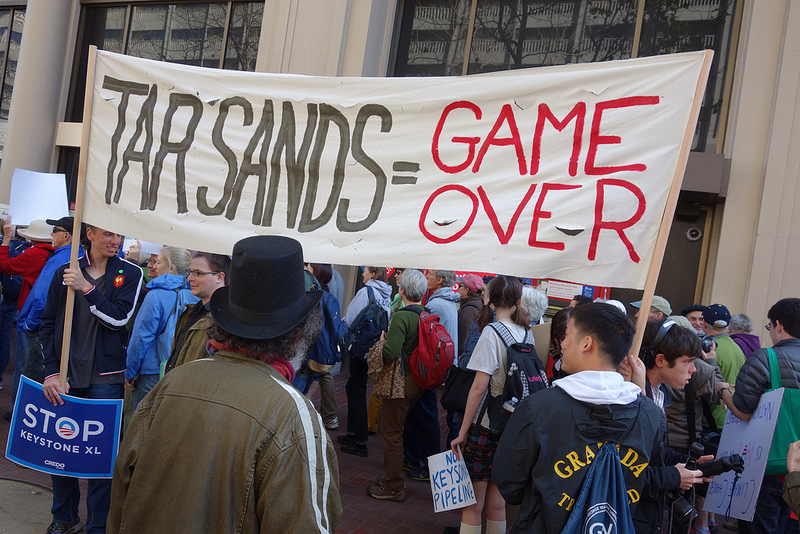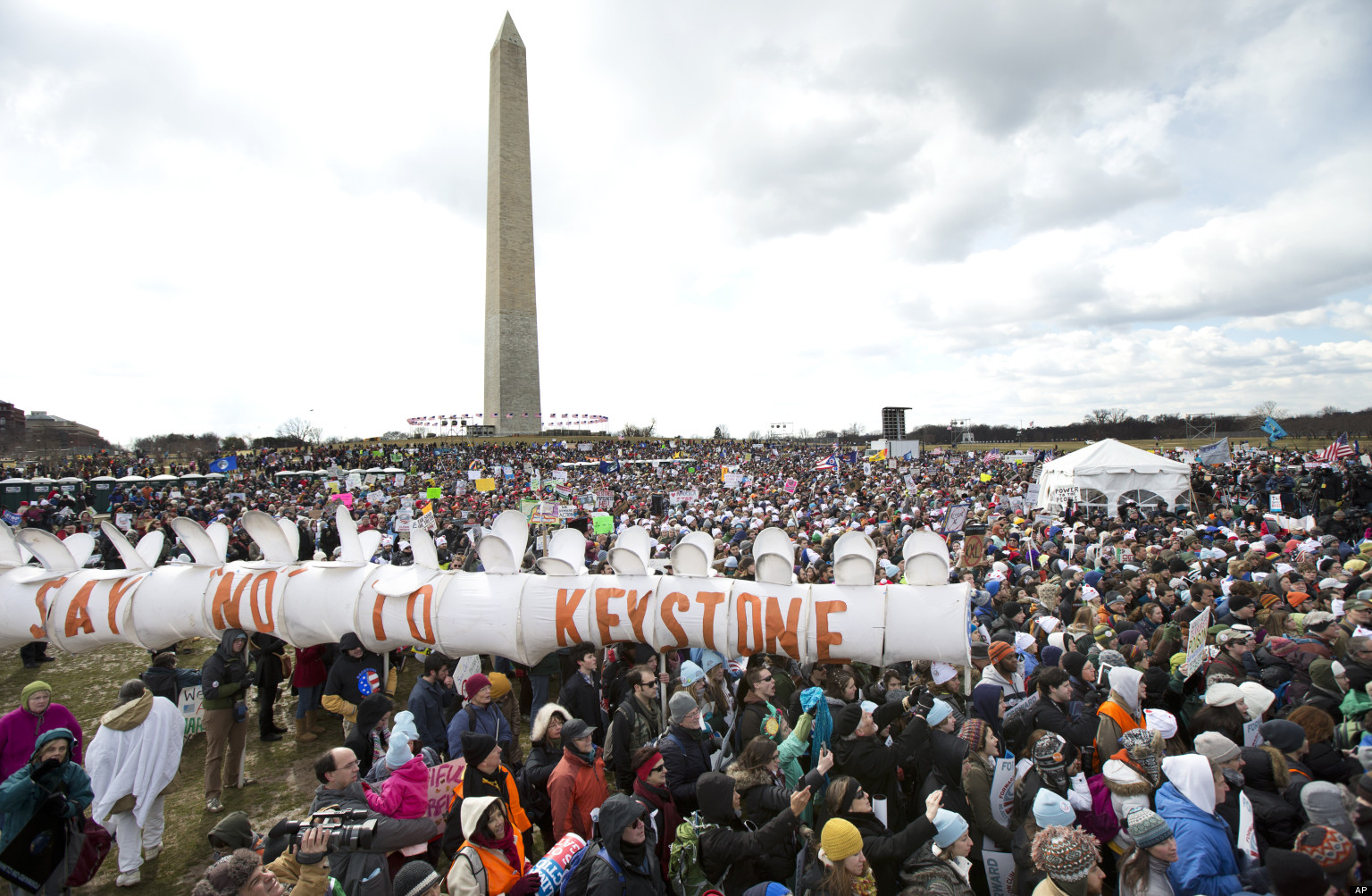
| From 1995-2005, Rick Piltz held senior positions in the Coordination Office of the U.S. Global Change Research Program. In the spring of 2005, Piltz resigned in protest of the Bush administration’s political interference with climate change science. His whistleblower documentation of politically motivated White House censorship of climate science intended for the public and Congress was widely reported in the media. |
Why did the State Department redact from a public document the information that experts who helped draft the Supplementary Environmental Impact Statement (SEIS) for the hotly contested Keystone XL tar sands pipeline had previously worked for the company that would build the pipeline, as well as oil companies that would benefit economically from its construction?
The question signals yet another flashpoint in the ongoing battle over whether the Obama administration will grant a construction permit for an essential 875-mile component of a system designed to transport up to 830,000 barrels per day of carbon-intensive tar sands from Alberta to petroleum refineries on the Texas Gulf Coast.
Mother Jones reported on March 21 that specific information about previous work done for TransCanada, ExxonMobil, BP, and Koch Industries by experts with the lead consulting firm Environmental Resources Management (ERM) was not disclosed by the State Department.
State had allowed TransCanada to select ERM as the consulting firm that would take the lead in preparing the SEIS.
ERM had represented to the State Department that it was free from any conflicts of interest in working on the SEIS. Apparently, ERM and State don’t consider it a conflict of interest that ERM’s deputy manager of the pipeline impacts study has a tie to TransCanada.
| “Someone on the inside should tell us how it was decided that this conflict of interest is appropriate in an administration that touts its transparency” |
In any case, the study, drafted by ERM on contract to TransCanada, is now a U.S. government document.
Whether the relationship between the State Department, TransCanada, and ERM in the preparation of the Keystone XL SEIS is subject to a formal challenge by opponents of the pipeline remains to be seen. But in any case, the public document gatekeepers at the State Department acted as if they had something to hide. Given the political tension around Keystone XL, and the way ERM’s Environmental Impact Statement plays down concerns about the potential harm of granting a construction permit, perhaps they do.
This is why we need whistleblowers
This appears to be yet another case in which it would be helpful to have an internal whistleblower who could tell us more about exactly what is going on at the State Department as it moves toward making a determination, as required by law for a pipeline crossing the U.S. border, of whether the proposed project is in the national interest.
The Canadian website DeSmogBlog — examining ERM’s role in 2002 in helping to gain approval for a controversial 1,300 mile-long pipeline that carries oil and gas produced in the Caspian Sea westward to the export market — raises questions about who ERM really represents when it issues a supposedly independent report on whether a project is environmentally and socioeconomically sound.
ERM was called into action on producing a Draft Supplementary Environmental Impact Statement for the Keystone XL when an earlier version offered by TransCanada two years ago was challenged by the Environmental Protection Agency. The 2011 version failed to provide adequate environmental information on key issues, EPA said, and failed to address the implications of the project’s greenhouse gas emissions. The State Department sent the impact assessment back to the drawing board for another try.
The State Department posted the new TransCanada/Environmental Resources Management Draft SEIS on March 1 for a 45-day period of public review and comment. We can expect that a large number of comments — hundreds of thousands, perhaps — will be submitted electronically and recorded in a database. But apparently the State Department does not intend to allow the public to view the full docket of comments, short of filing a Freedom of Information Act request. Why not?
On top of that, Inside Climate news reported on March 25 that Environmental Resources Management also holds the contract to build the electronic portal for receiving comments on its work, and will also be responsible for “summarizing the comments and incorporating changes based on them into the final report.” Does Secretary of State Kerry know about this cozy arrangement? Someone on the inside should tell us how it was decided that it is appropriate in an administration that touts its transparency.
TransCanada’s manufacturing of consent
So what has TransCanada/Environmental Resources Management put forth in its four-volume, 2,000-page Draft SEIS
![]() The report covers a wide range of topics in considerable detail. It does not make a formal recommendation on the pipeline, but it can be read as a brief in favor of granting the permit — as, in essence, an attempt to provide cover for Obama and Kerry in approving it.
The report covers a wide range of topics in considerable detail. It does not make a formal recommendation on the pipeline, but it can be read as a brief in favor of granting the permit — as, in essence, an attempt to provide cover for Obama and Kerry in approving it.
For the more than 1,200 individuals who were arrested for civil disobedience at the White House protesting the pipeline in the summer of 2011, and for the several tens of thousands who demonstrated at the Forward on Climate rally in Washington, D.C., on February 17, the Draft SEIS report can be characterized in terms of how it bears on a few core arguments.
The Draft SEIS examines environmental impacts of the construction and operation of the pipeline on soils, surface and groundwater resources, wetlands, wildlife, fisheries, threatened and endangered species, land use and recreation, cultural resources, air quality and greenhouse gases, noise, and potential releases, as well as socioeconomic impacts. All in all, it does not appear to raise any concerns that would clearly be significant obstacles to approval.

The public review of the draft assessment will raise counter-arguments about pipeline impacts and question the adequacy of ERM’s analysis. Whether they will be sufficiently powerful to sway the State Department remains to be seen, though it appears to be an uphill climb at this point — if the focus is on the pipeline itself, rather than the broader implications for climate change of enabling the full development of the Canadian tar sands deposits.
In his now-famous “Game Over for the Climate” op-ed in The New York Times, James Hansen of NASA, the most eminent federal climate scientist, established the scientific bottom line on the tar sands problem:
Global warming isn’t a prediction. It is happening. That is why I was so troubled to read a recent interview with President Obama in Rolling Stone in which he said that Canada would exploit the oil in its vast tar sands reserves “regardless of what we do.”
If Canada proceeds, and we do nothing, it will be game over for the climate.
Canada’s tar sands, deposits of sand saturated with bitumen, contain twice the amount of carbon dioxide emitted by global oil use in our entire history. If we were to fully exploit this new oil source, and continue to burn our conventional oil, gas and coal supplies, concentrations of carbon dioxide in the atmosphere eventually would reach levels higher than in the Pliocene era, more than 2.5 million years ago, when sea level was at least 50 feet higher than it is now. That level of heat-trapping gases would assure that the disintegration of the ice sheets would accelerate out of control. Sea levels would rise and destroy coastal cities. Global temperatures would become intolerable. Twenty to 50 percent of the planet’s species would be driven to extinction. Civilization would be at risk.
That is the long-term outlook. But near-term, things will be bad enough.
The fallacy of the “it’s going to happen anyway” argument
There are many arguments against Keystone XL (here are 23 of them). But the most essential is that it will enable the full development of the Canadian tar sands, an enormous pool of carbon that the oil industry has every intention of extracting, transporting, refining, and sending into the global market to be burned.
A policy with scientific integrity and commensurate with the magnitude and urgency of the problem of global climate disruption would call for leaving most of the known fossil fuel reserves in the ground. If the tar sands can find a way to the market, they will be fully developed. If we can’t say no to this, where will we draw the line? If we allow development of “all-of-the-above” fossil fuel resources, including unconventional resources such as the tar sands, what hope is there for expediting the necessary phase-out of fossil fuels and the fundamental transformation to a clean energy system?
What hope is there for preventing disastrous climate change?
| “Keystone XL is essential to tar sands production. That is why the oil industry is making such a push.” |
Hansen and other leading scientists are looking at this big picture. “President Obama has the power not only to deny tar sands oil additional access to Gulf Coast refining, which Canada desires in part for export markets, but also to encourage economic incentives to leave tar sands and other dirty fuels in the ground,” he says. And so is the climate movement that is taking an increasingly oppositional, activist stance against dirty energy development.
The Draft SEIS tries to make this argument go away, at least for purposes of permitting the Keystone XL, by contending that Canada will develop and transport the tar sands regardless of whether they do it via the Keystone XL or an alternative method. It’s hopeless to try to stop tar sands development, it suggests:
Based on information and analysis about the North American crude transport infrastructure (particularly the proven ability of rail to transport substantial quantities of crude oil profitably under current market conditions, and to add capacity relatively rapidly) and the global crude oil market, the draft Supplemental EIS concludes that approval or denial of the proposed Project is unlikely to have a substantial impact on the rate of development in the oil sands, or on the amount of heavy crude oil refined in the Gulf Coast area.
The alternative of moving the tar sands by rail would be more expensive and entail even more greenhouse gas emissions, the Draft EIS says, as would the alternative of transport by tanker from the Pacific Coast of Canada. Development of the tar sands would be slowed — but not stopped. “The product has to get to where it has to go,” says TransCanada CEO Russ Girling. “Rail cars have moved oil forever and will continue to.” And they don’t need a permit from the State Department.
Tar sands trains may be a real prospect, if political controversy blocks the Keystone XL pipeline in the U.S. and pipeline alternatives in Canada. Rail transport of oil in the U.S. and Canada is substantial and growing – 17,000 carloads a week, carrying roughly 1.5 millions barrels a day.
But the essential premise of the Draft SEIS, that rail transport is a viable alternative to the Keystone XL for moving tar sands from Canada to the Gulf Coast, is challenged by an analysis that says it is based on misleading assumptions about transportation costs. Keystone XL is essential for enabling major expansion of tar sands production, this critique says, and that is why the oil industry is making such a push to get it approved.
For Obama, there is no win-win
Will Obama cave in to the “it’s going to be developed anyway” argument? That would help him rationalize a decision to approve the pipeline, and thus avoid antagonizing the oil industry and the Canadian government, as well as much of Congress, including some of the Democrats, and at least some of the labor unions? Of course, in doing so he would be giving the back of his hand to a progressive movement that has mounted a serious campaign against the pipeline and is treating it as a litmus test of Obama’s integrity and accountability on climate change.
He has no win-win options here. He can’t have it both ways. He can’t continue to put forward an “all of the above” approach to energy development if he is going to follow through on the rhetoric in his second Inaugural Address and 2013 State of the Union speech about our responsibility to the next generations to deal effectively with climate change.
It’s a big ask, calling on Obama to take the position that it is not in the U.S. national interest to be complicit in developing the tar sands. It will take some courage to act on the warning from the courageous James Hansen, who has said:
We need to limit the climate forcing severely. Moving to tar sands, one of the dirtiest, most carbon-intensive fuels on the planet, is a step in exactly the opposite direction, indicating either that governments don’t understand the situation or that they just don’t give a damn. People who care should draw the line.
What will it take to get Obama to decide it’s in his interest to pick a fight with corporate power and align the “national interest” with the climate scientists and the climate activists? What will it take to get Kerry to push him hard on this decision? They won’t get it from the oil industry-oriented environmental impact statement, or from document-redacting officials at the State Department.
Rick Piltz is a Special Correspondent for The Washingston Spectator and founder of Climate Science Watch, a program of the Government Accountability Project in Washington, D.C. Follow him @ClimateSciWatch and @WashSpec.



0 Comments